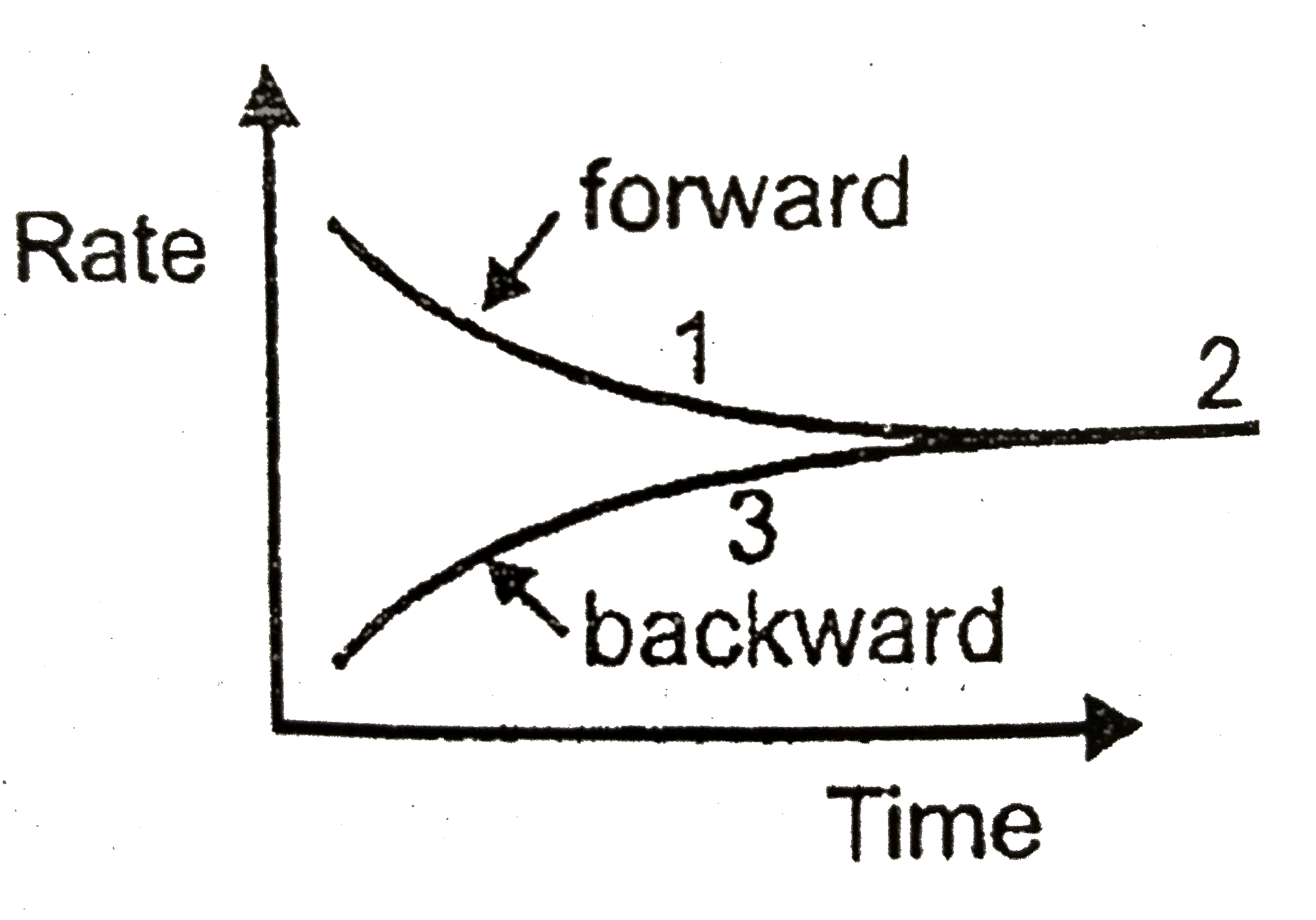In the following reaction:
2NO(g)+Cl2(g)⇔2NOCl(g)
it is observed that equilibrium is not attained and the rate of forward reaction is greater than rate of backward reaction. Which of the following is true for the reaction ?
(A) K
p
=
Q
p
(B) Q
p
>
K
p
(C) Q
p
<
K
p
(D) Q
p
=
0
Kp=Qp
Qp>Kp
Qp<Kp
Qp=0
The correct Answer is:C
To solve the problem, we need to analyze the given reaction and the information provided about the rates of the forward and backward reactions.
1. Understanding the Reaction:
The reaction given is:
2NO(g)+Cl2(g)⇌2NOCl(g)
This is a reversible reaction where nitrogen monoxide (NO) and chlorine (Cl2) react to form nitrosyl chloride (NOCl).
2. Equilibrium Concept:
In a reversible reaction, equilibrium is attained when the rate of the forward reaction equals the rate of the backward reaction. At this point, the concentrations of reactants and products remain constant.
3. Given Information:
- It is stated that equilibrium is not attained.
- The rate of the forward reaction is greater than the rate of the backward reaction.
4. Implications of the Given Information:
Since the forward reaction is faster, this means that the concentration of products (NOCl) is increasing while the concentration of reactants (NO and Cl2) is decreasing. Therefore, we can conclude that the reaction is still moving towards the formation of more products.
5. Understanding Reaction Quotient (Qp):
The reaction quotient Qp is defined as:
Qp=(PNOCl)2(PNO)2⋅(PCl2)
where P represents the partial pressures of the respective gases.
6. Comparing Qp and Kp:
- Kp is the equilibrium constant, which is a constant value at a given temperature when the system is at equilibrium.
- Since the forward reaction is favored and products are being formed, Qp must be less than Kp because equilibrium has not been reached yet.
7. Conclusion:
Since the concentration of products is increasing and the concentration of reactants is decreasing, we can conclude that:
Qp<Kp
Therefore, the correct answer is:
(C) Qp<Kp.
The reaction given is:
2NO(g)+Cl2(g)⇌2NOCl(g)
This is a reversible reaction where nitrogen monoxide (NO) and chlorine (Cl2) react to form nitrosyl chloride (NOCl).
In a reversible reaction, equilibrium is attained when the rate of the forward reaction equals the rate of the backward reaction. At this point, the concentrations of reactants and products remain constant.
- It is stated that equilibrium is not attained.
- The rate of the forward reaction is greater than the rate of the backward reaction.
Since the forward reaction is faster, this means that the concentration of products (NOCl) is increasing while the concentration of reactants (NO and Cl2) is decreasing. Therefore, we can conclude that the reaction is still moving towards the formation of more products.
The reaction quotient Qp is defined as:
Qp=(PNOCl)2(PNO)2⋅(PCl2)
where P represents the partial pressures of the respective gases.
- Kp is the equilibrium constant, which is a constant value at a given temperature when the system is at equilibrium.
- Since the forward reaction is favored and products are being formed, Qp must be less than Kp because equilibrium has not been reached yet.
Since the concentration of products is increasing and the concentration of reactants is decreasing, we can conclude that:
Qp<Kp
Therefore, the correct answer is:
(C) Qp<Kp.
Topper's Solved these Questions
- EQUILIBRIUM BOOK - NCERT FINGERTPS ENGLISHCHAPTER - EQUILIBRIUM EXERCISE - HOTS
6 Videos
- EQUILIBRIUM BOOK - NCERT FINGERTPS ENGLISHCHAPTER - EQUILIBRIUM EXERCISE - EXEMPLAR PROBLEMS
19 Videos
- ENVIRONMENTAL CHEMISTRYBOOK - NCERT FINGERTPS ENGLISHCHAPTER - ENVIRONMENTAL CHEMISTRYEXERCISE - Assertion And Reason
15 Videos
- HYDROCARBONS BOOK - NCERT FINGERTPS ENGLISHCHAPTER - HYDROCARBONS EXERCISE - Assertion And Reason
15 Videos
Similar Questions
In the following reaction :
2SO2(g)+O2(g)⇔2SO3(g)
the equilibrium is not attained . The rate of forward reaction is greater than that of backward. Thus, which of the following is the correct relation between Kp and Qp ?
View SolutionMass action rato or reaction quotient Q for a reaction can be calculate using the law of masss action
A(g)+B(g)⇔C(g)+D(g)
Q=[C][D][A][B]
The value of Q decides whether the reaction is at equilibrium or not.
At equilibrium, Q=K
For an equilibrium process, Q≠K
when Q>K, reaction will favour backward direction and when Q<K, it will favour direction.
Answer the following questions:
In the following reaction:
2SO2(g)+O2(g)⇔2SO3(g)
the equilibrium is not attained. The rate of forward reaction is greater than that of backward reaction. Thus, which of the following is the correct relation between Kp and Qp?
View Solution
Knowledge Check
For the reaction, CO(g)+Cl2(g)⇔CoCl2(g), the value of Kp/Kc is equal to
A1BRTC√RTD1RTFor the reactions,
CO(g)+Cl2(g)⇔COCl2(g), the KPKc is equal toA1RTBRTC√RTD1.0
For the reaction, N2(g)+3H2(g)⇔2NH3(g), the units of Kp are …………
View SolutionAt equilibrium for a reaction A↔B.
correct representation is {rf= rate of forward reaction, rb = rate of backward reaction}
View SolutionFor the reaction , CO(g)+Cl(g)⇔COCl2(g) then Kp/Kc is equal to :
View SolutionFor the following equilibrium
N2O4(g)⇔2NO2(g)
Kp is found to be equal to Kc. This is attained when :
View SolutionIn the reaction
PCl5(g)⇔PCl3(g)+Cl2(g)
a graph in plotted to show the variation of rate of forward and backward
reactions against time. Which of the following is correct?

Q>K Q=K Q<K
View SolutionThe yield of product in the reaction 2A(g)+B(g)⇔2C(g)+Q K J would be lower at :
View Solution
